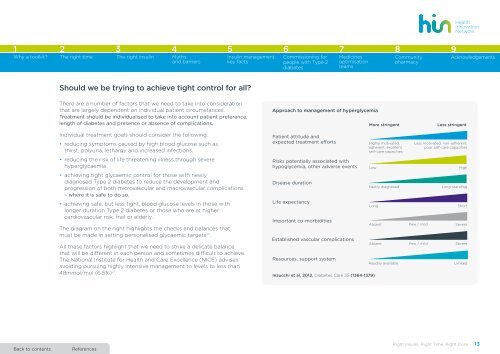1gOgRTa
1gOgRTa
1gOgRTa
You also want an ePaper? Increase the reach of your titles
YUMPU automatically turns print PDFs into web optimized ePapers that Google loves.
1 2 3 4 5 6 7 8Why a toolkit?The right time The right insulin Mythsand barriersInsulin management:key factsCommissioning forpeople with Type 2diabetesMedicinesoptimisationteamsCommunitypharmacy9AcknowledgementsShould we be trying to achieve tight control for all?There are a number of factors that we need to take into considerationthat are largely dependent on individual patient circumstances.Treatment should be individualised to take into account patient preference,length of diabetes and presence or absence of complications.Individual treatment goals should consider the following:• reducing symptoms caused by high blood glucose such asthirst, polyuria, lethargy and increased infections.• reducing the risk of life threatening illness through severehyperglycaemia.• achieving tight glycaemic control for those with newlydiagnosed Type 2 diabetes to reduce the development andprogression of both microvascular and macrovascular complications– where it is safe to do so.• achieving safe, but less tight, blood glucose levels in those withlonger duration Type 2 diabetes or those who are at highercardiovascular risk, frail or elderly.The diagram on the right highlights the checks and balances thatmust be made in setting personalised glycaemic targets 20 .All these factors highlight that we need to strike a delicate balancethat will be different in each person and sometimes difficult to achieve.The National Institute for Health and Care Excellence (NICE) advisesavoiding pursuing highly intensive management to levels to less than48mmol/mol (6.5%) 21 .Approach to management of hyperglycemiaPatient attitude andexpected treatment effortsRisks potentially associated withhypoglycemia, other adverse eventsDisease durationLife expectancyImportant co-morbiditiesEstablished vascular complicationsResources, support systemMore stringentHighly motivated,adherent, excellentself-care capacitiesLowNewly diagnosedLongAbsentAbsentInzucchi et al, 2012, Diabetes Care 35 (1364-1379)Readily availableLess stringentLess motivated, non-adherent,poor self-care capacitiesFew / mildFew / mildHighLong-standingShortSevereSevereLimitedBack to contentsReferencesRight Insulin, Right Time, Right Dose 13


